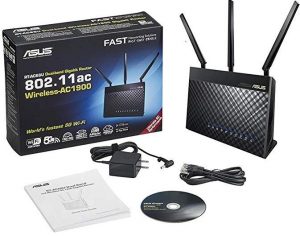
This section of this website provides detailed information on all of the aspects of cabled and wireless networking that use the networking capabilities of Windows from Windows XP to Windows 10. Information is provided on cabled peer-to-peer networks with additional interesting information on network home servers, drive mapping and network-attached storage (NAS) devices.
Wireless networking and the wireless-networking – WiFi standards 802.11b, 802.11g, 802.11n, 802.11ac – are dealt with, including information on ADSL modem routers and cable routers, Bluetooth connectivity is not a wireless network technology but can be used in similar ways, so it is also dealt with.
Click on CONTENTS to skip the following useful information on networking and go to the CONTENTS menu on this page.
Dual-band routers
Note that dual-band routers can broadcast on both the 2.4GHz and 5.0GHz bands, but they cannot swap between them in order to broadcast the best signal. What they do is make it possible for client network adapters on computers that support either or both of the bands to receive broadcasts. For example, some older network adapters on laptops might only support the 2.4GHz band, so they will be able to receive a signal as well as laptops set to use the 5.0GHz band.
Note that the Wi-Fi 6E standard that became available in 2022 adds the new 6GHz band, so there are already triple-band routers. An example of a 6E router is the Asus ROG Rapture Gaming router that was priced at $550.00 in 2022.
Dual-Band Wireless Networking Explained –
https://www.lifewire.com/dual-band-wireless-networking-explained-818279
Does Dual-Band Router Switch Automatically? | How-to Guide –
https://www.techwhoop.com/does-a-dual-band-router-switch-automatically/
Beamforming
What is “Beamforming” on a Wireless Router? –
“In summary, beamforming is a useful feature, though you’ll only really get all the benefits with new 802.11ac devices. You shouldn’t necessarily pay a lot more for a beamforming-enabled router.”
https://www.howtogeek.com/220774/htg-explains-what-is-beamforming-on-a-wireless-router/
New names for the wireless 802.11 Wi-Fi network standards
Here are the new names for the 802.11 wireless standards currently in use:
Wi-Fi 4 is 802.11n, released in 2009.
Wi-Fi 5 is 802.11ac, released in 2014.
Wi-Fi 6 is the new version, also known as 802.11ax
Wi-Fi 6E is a new version of Wi-Fi 6.
WiFi 6 vs WiFi 6E – The One Huge Difference – the new 6GHz band, introduced in 2022, provides ultra-high 1500 to 1800 gigabit speeds. Note that 6E requires Windows 11. If a Wi-Fi 6E router is run on Windows 10, it runs at Wi-Fi 6 speeds. Also note that the higher the frequency, the lower the range. 6E has a lower range than the 5GHz band, which itself is lower than the 2.4GHz band.
What is Wi-Fi 7? – Everything You Need to Know –
https://www.wired.com/story/what-is-wi-fi-7/
IEEE 802.11ax – https://en.wikipedia.org/wiki/IEEE_802.11ax
Wi-Fi 6 – https://www.wi-fi.org/discover-wi-fi/wi-fi-certified-6
Note that Wi-Fi 4, 5 and 6 and 6E are backwards compatible with one another, so Wi-Fi 4 and 5 devices won’t stop working when devices that run the Wi-Fi 6 or 6E standard is introduced.
Here are what would have been the new names for the superseded 802.11 standards:
Wi-Fi 1 would have been 802.11b, released in 1999.
Wi-Fi 2 would have been 802.11a, also released in 1999.
Wi-Fi 3 would have been 802.11g, released in 2003.
Wi-Fi 7 is Already Coming: The BIGGEST Upgrades –
https://www.youtube.com/watch?v=7folUqzSwes
What are Wi-Fi 5 and Wi-Fi 6? Why –
https://www.pocket-lint.com/laptops/news/145950-what-are-wi-fi-5-and-wi-fi-6
The video below is a discussion with a router expert from router-manufacturer Asus lasting 2 hours 20 minutes. Modern routers can provide security features when enabled, such as blocking malicious or hacked websites.
Map a network drive in Windows 10
“Map a network drive to get to it from File Explorer in Windows without having to look for it or type its network address each time.”
https://support.microsoft.com/en-us/windows/…
How to use a smartphone as a mobile hotspot
“Using your phone as a hotspot makes the internet available just about anywhere and anytime. With 5G speeds thrown in, it’s a solution that rivals your office Wi-Fi.”
https://www.computerworld.com/article/2499772/how-to-use-a-smartphone-as-a-mobile-hotspot.html
CONTENTS
- – Network diagnostics and troubleshooting
- – Using a HomeGroup instead of a Workgroup – A wireless guest network – Port forwarding
- – The 802.11ac Wi-Fi standard, Powerline Ethernet and Wi-Fi mains networks and Bluetooth wireless connectivity
- – PCI and PCI Express Ethernet Network Interface Cards (NICs), Powerline adapters & USB Wi-Fi dongles
- – Range extenders & using other Wi-Fi routers & access points to extend the range of a Wi-Fi network
- – NIC MAC Address
- – Network Home Servers
- – Free networking security diagnostic tools and utilities
- – Routers – ADSL modem routers and dedicated cable routers
- – Wireless network security: WEP, WPA, and WPA2 encryption
- – Wi-Fi Protected Setup (WPS) also known as Quick Security Setup (QSS)
- – Router firmware
- – Quality of Service (QoS) capability of a router
- – How can I add extra wired (Ethernet) ports to my wireless router?
- – Virtual Private Networking (VPN)
- – HPNA telephone networks
POST – What is a network switch?
POST – All about Ethernet network cables – Cat 6 to Cat 8
POST – Use Apple or Android smartphones without SIM card and a mobile service provider
POST – How to make use of a router’s USB port
POST: What to do if your ISP-supplied modem router can’t keep up with multiple Wi-Fi demands
POST: What you need to know about WiFi routers and related matters
POST: Stop third parties with Wi-Fi access from changing a Sonos music playlist
POST: How best to make a wireless Wi-Fi router network secure
POST: Measures that help prevent buffering of video streaming
NEXT PAGE – Network troubleshooting